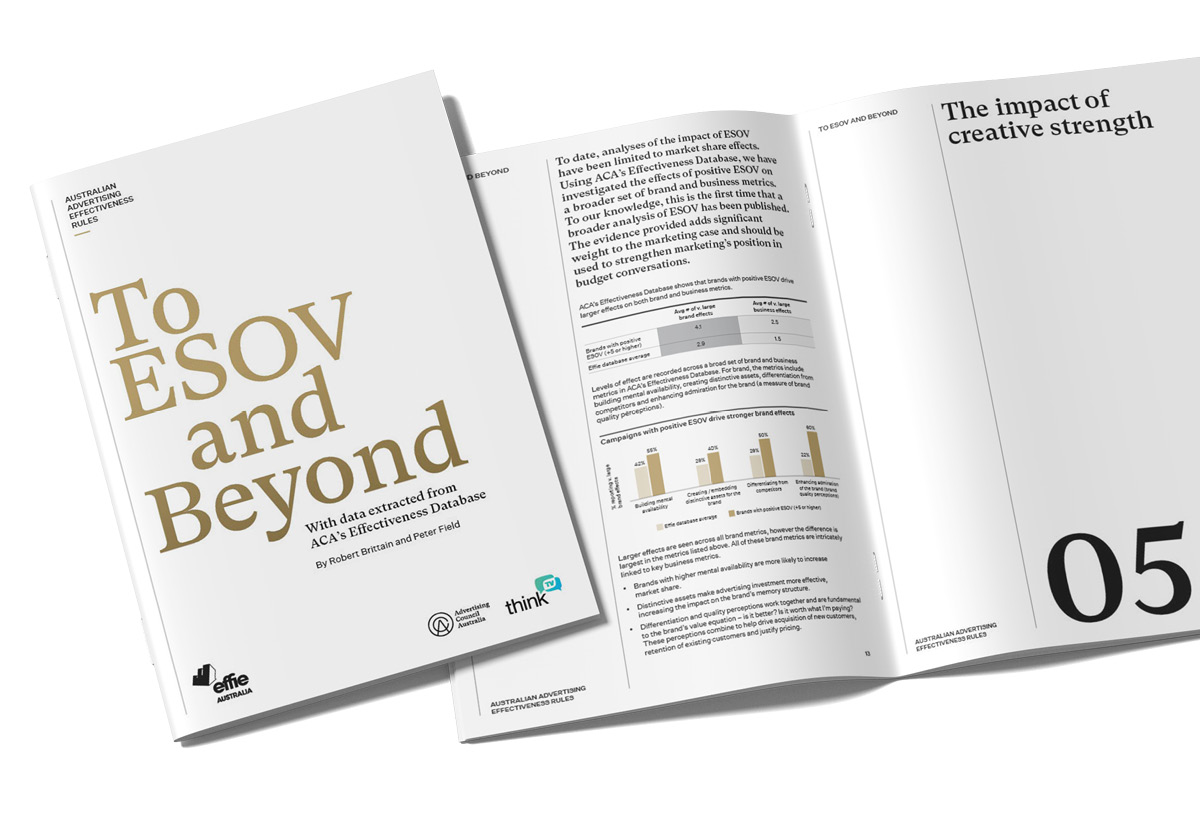ACA launches new report: Australian Advertising Effectiveness Rules: To ESOV and Beyond

Smart advertisers and brands that ensure ‘extra share of voice’ (ESOV) can now directly link ESOV to driving stronger pricing effects and customer acquisition.
This is one of the key findings of a major new report released today by Advertising Council Australia (ACA) in association with co-authors and advertising effectiveness luminaries Robert Brittain and Peter Field, and globally-acclaimed researcher in media science, Professor Karen Nelson-Field.
The first-of-its kind report, Australian Advertising Effectiveness Rules: To ESOV and Beyond, analyses the pivotal role advertising investment plays in creating and converting demand for brands, the relationship between mental availability, extra share of voice (ESOV) and key business metrics, and how advertisers should be setting their budgets to grow.
Its findings are based on analysis of ACA’s Effectiveness Database which contain hundreds of advertising campaign award entries judged on their effectiveness and proven results in the marketplace, revealing that:
– Building mental availability is key to brand growth. It is a competitive metric driven by three major forces: budget, media channels and creative strength.
– ESOV is a simple but powerful methodology for determining a brand’s media budget, and is linked to mental availability gains and a raft of key business metrics.
– ESOV shows a strong link with pricing sensitivity effects, highlighting that advertising not only has a role in driving sales growth but also in underwriting margin expansion.
– From a budget perspective, it is ESOV, not absolute media investment, that is more important to campaign effectiveness. Highly effective campaigns can therefore be achieved by brands of any size.
– Allocation of media spend to video channels is an important factor.
– ESOV is an important metric not only for budget setting but for the interpretation of results, however there are some inherent threats to this powerful methodology that we need to solve to move forward and reap the true benefits of ESOV:
1. SOV is getting more difficult to measure
2. The media marketplace has become increasingly dysfunctional
3. Creative strength makes a huge difference, and
4. Share of search is not a replacement for SOV
The more attention paid to an advertisement, the stronger its impact on sales. Therefore one possible approach to counter the threats to the methodology is the use of attention metrics to adjust SOV.
Says co-author Rob Brittain: “To our knowledge, this is the first time that broader analysis of ESOV has been published and the results are significant.
“Our analysis shows that brands with a positive ESOV; being those whose share of advertising spend is higher than their share of the market, were able to strengthen pricing and acquire more new customers.
“ESOV is therefore a critical planning metric that all marketers should be using to capitalise on the economic recovery and regain pre-recession levels of sales and profitability.
“Advertising is critical to this and planning marketing budgets using the ESOV approach will put businesses in a good position to drive both sales growth and margin expansion.
“Quite simply, the business case for treating advertising as a growth lever and not just a cost to the business has never been clearer.”
Peter Field commented that the report’s focus on the use of attention metrics to adjust SOV is an important step forward globally in helping advertisers and brands understand what the appropriate level of advertising investment should be: “Professor Karen Nelson-Field’s world-renowned experience in the field of attention measurement answers the growing problem of how investment across competing video advertising channels should be balanced: impacts are not equal. All marketers need to know this.
“After the destructive impacts of a pandemic-induced recession, and more than ten years of disinvestment in brand advertising, the marketing industry needs a study of this kind to guide it back to driving growth. It is an invaluable playbook for recovery, providing the evidence marketers need to build the case for brand advertising.”
Says Tony Hale, CEO, Advertising Council Australia: “Utilising ACA’s Effectiveness Database has meant that we have been able to provide further insights into the vital role ESOV can play in achieving mental availability and market growth, and the challenges this powerful methodology faces today.
“There is no doubt that this report will generate reverberations around the globe as marketing analysts consider the implications and how they should be applied to develop more effective campaigns in an increasingly complicated media and creative landscape.”
Australian Advertising Effectiveness Rules: To ESOV and Beyond will be available for public download from 5.00pm AEST, Thursday, 1 July here https://bit.ly/3hambkP

1 Comment
I tuned into this webinar and there are definitely gold nuggets for the creative department in this report… especially some of the evidence around share of attention